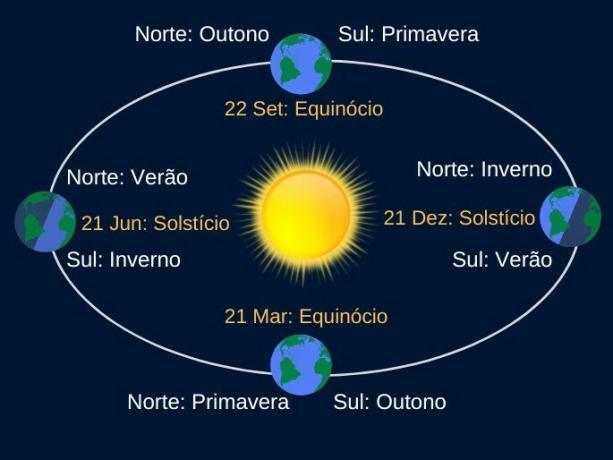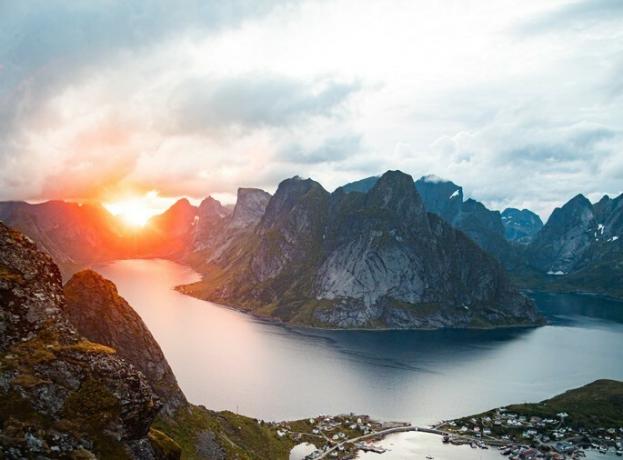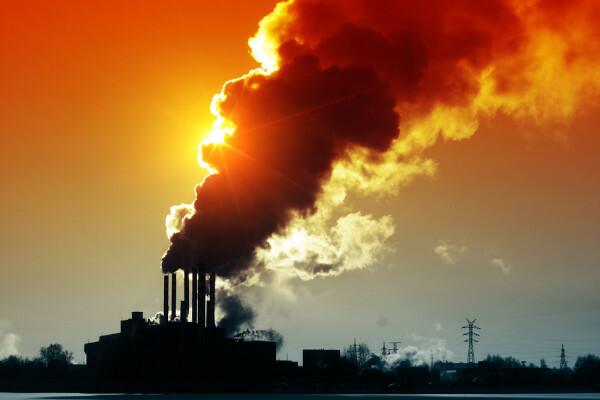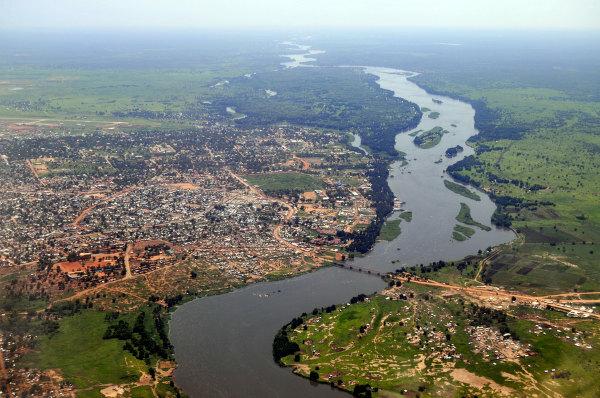The seasons of the year are periods, of about three months each, that have specific climatic characteristics. They are: summer, autumn, winter and spring.
These changes in climate and temperature mark the periods when the Earth's northern and southern hemispheres receive more or less sunlight.
THE summer in the Southern Hemisphere, where Brazil is, starts in December 20th or 21st. It is the hottest season of the year with the longest days.
THE autumn starts in March 20th or 21st. It is the season of milder temperatures and a drop in air humidity.
THE Winter starts at 20th or 21st of June, being the season of cold and dry climate.
already the spring starts in September 22 or 23. Just like autumn, it is a season of mild weather, but with a gradual increase in air humidity.
Summer

When happens:
- Southern Hemisphere: Starts December 20 or 21 and ends March 20 or 21.
- Northern Hemisphere: starts on June 20 or 21 and ends on September 22 or 23.
Summer is the season when you get the most sunlight. The days are longer and the temperatures are higher. There is also an increase in air humidity, as the heat makes the phenomenon of water evaporation happen faster.
With higher humidity, there is more rain, which is usually quick, but heavy. It's the summer rains.
The Southern Hemisphere's summer is called the austral summer, while the Northern Hemisphere's is the boreal summer.
Autumn

When happens:
- Southern Hemisphere: Starts March 20 or 21 and ends June 20 or 21.
- Northern Hemisphere: starts on September 22 or 23 and ends on December 20 or 21.
Autumn is an intermediate season. It is the season that prepares, little by little, the change from summer to winter. During autumn, the previously high temperatures gradually drop, as does the humidity. It has a mild and drier climate. The days also get shorter.
Throughout autumn, the flora begins to prepare for winter: the leaves on the trees turn yellow and then fall off, in order to save energy for the next season, winter, which is more severe.
During this period, the Earth's Northern and Southern Hemispheres are receiving roughly the same amount of sunlight.
Autumn in the Southern Hemisphere is called austral autumn, while in the Northern Hemisphere is northern autumn.
Winter

When happens:
- Southern Hemisphere: starts on June 20 or 21 and ends on September 22 or 23.
- Northern Hemisphere: starts on December 20 or 21 and ends on March 20 or 21.
Winter is the season when the incidence of solar rays is lower, causing a drop in temperatures and a decrease in air humidity.
In some places there is the occurrence of snow, which happens when the water in the clouds ends up freezing due to low temperature. The water changes to a solid state, forming ice crystals, and falls as snow.
Winters at the Earth's poles are extremely harsh, with very low incidence of sunlight. The extensive ice surfaces help to lower the temperature even further, as they reflect part of the little light that reaches the region, causing even lower temperatures.
During winter, both the North and South Poles are without sunlight. It's 24 hours at night.
The Southern Hemisphere's winter is called the austral winter, while the northern winter is called the boreal winter.
Spring

When happens:
- Southern Hemisphere: Starts September 22 or 23 and ends December 20 or 21.
- Northern Hemisphere: Starts March 20 or 21 and ends June 20 or 21.
Like autumn, spring is an intermediate season. It is responsible for transforming the characteristics of winter into summer. In spring, the two hemispheres of the planet receive practically the same incidence of solar rays.
Temperatures are mild and gradually increase as summer approaches. As well as humidity.
Spring is known as the season of flowers. After the winter, when the flora was without leaves to save energy and survive the low temperatures, the The arrival of spring brings warmth and humidity, allowing leaves and flowers to grow again and reproduce.
Some animals, which usually hibernate in the winter, wake up and leave their shelters. This is the case with bats, ground squirrels and some types of bears.
Spring in the Southern Hemisphere is known as the austral spring. While that of the Northern Hemisphere is the boreal spring.
order of seasons
In Brazil and throughout the Southern Hemisphere, the seasons occur in the following order, starting from the beginning of the year (January):
Summer autumn Winter Spring.
In the Northern Hemisphere, the seasons happen in reverse: while in Brazil the year begins with the heat of summer, in the North it is winter that is happening. And so on: then it will be spring, summer and autumn.
Seasons of the year in Brazil
Brazil has a tropical climate. The country is located between the Tropic of Cancer, in the North, and the Tropic of Capricorn, in the South, which makes it classified as such.
Temperatures are usually higher than in the rest of the world, above 20 °C. The rains are also recurrent.
In the Tropical climate there are sub-climates that characterize the differences in temperature and rainfall in the different regions of Brazil. However, in general, the country does not have well-defined seasons.
It can be said that Brazil has only two climatic periods: one with more heat and rain, which would be the summer, and another drier, the winter.
The proximity to the Equator makes Brazil receive approximately the same amount of sunlight throughout the year. Especially the North and Northeast regions.
However, the southern region is already located in a temperate area, below the Tropic of Capricorn. In the southern states of Brazil the seasons are well defined.
Read more about the features of tropical weather.
Why do seasons exist?
These climate changes happen for two reasons: the first is the movement that the planet Earth makes around the sun, called translation.
This movement lasts approximately 365 days. Therefore, as the Earth revolves around the sun, there is a part of the planet that is exposed to more sunlight, while the other part receives less light.
The other factor that causes this phenomenon is the tilt of the Earth's axis, of about 23º. The slope accentuates the greater or lesser exposure of the Earth to the sun. Due to the angle at which the Earth is located, the northern and southern ends of the planet do not receive sunlight during its winter, for example.

Summer is characterized by being the season when it receives the most sunlight. Winter is the season when it receives less light. Autumn and spring are intermediate seasons, in these periods the two hemispheres of the Earth, North and South, receive practically the same amount of light.
Solstices and Equinoxes
The solstices and equinoxes are the days when the seasons change. The solstices mark the change to summer or winter. They are the periods in which part of the Earth will receive more or less solar incidence.
- Summer Solstice in the Southern Hemisphere: December 20 or 21.
- Winter Solstice in the Southern Hemisphere: June 20 or 21.
- Summer Solstice in the Northern Hemisphere: June 20 or 21.
- Winter Solstice in the Northern Hemisphere: December 20 or 21.
The dates are always the same in both hemispheres, but they are backwards. While in the Southern Hemisphere it is summer, in the Northern Hemisphere it is winter and vice versa.
The equinoxes mark the moment when the incidence of the sun is equivalent throughout the planet. This is the beginning of the intermediate seasons: autumn and spring.
As with the solstices, the dates of the equinoxes are the same, but they are always backwards when comparing the hemispheres. While it is autumn in the Southern Hemisphere, it is spring in the Northern Hemisphere and when it is autumn in the North, it will be spring in the South of the globe.
- Autumnal Equinox in the Southern Hemisphere: March 20 or 21.
- Spring Equinox in the Southern Hemisphere: September 22 or 23.
- Autumnal Equinox in the Northern Hemisphere: September 22 or 23.
- Northern Hemisphere Spring Equinox: March 20 or 21.
Know more about the differences between solstices and equinoxes.
Midnight Sun and White Nights

The midnight sun is a phenomenon that happens near the Earth's poles. The summer solstice, both in the South and in the North, marks the period when these regions receive the highest incidence of sunlight.
Due to the tilt of the Earth's axis, during this period, the poles will constantly receive light, causing the sun to never set.
Therefore, it is possible to see the sun when the clock reads zero hours, that is, what would be midnight.
White Nights is a famous cultural festival that takes place in Saint Petersburg, Russia. The party is called that because it celebrates the Summer Solstice on the days when the sun never sets, in an eternal twilight.
There are fireworks, music and outdoor cultural activities throughout the city.



